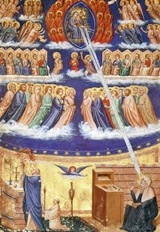


Miniature (ca 1400) of a Vision of St Bridget of Sweden
Pierpont Morgan Library, New York
An entry in the Roman Martyrology under 23rd July reads: “ At Rome, St. Bridget, widow, who, after many pilgrimages to the holy places, fell asleep filled with the Spirit of God. Her feast is [also] observed on the 8th of October, [the date of the translation of her relics]”.
St Bridget was born in 1303 in Upland, Sweden, the daughter of the provincial governor. She was married at the age of only fourteen to Ulf Gudmarsson and had eight children. When she was in her early thirties, she became a lady-in-waiting to Queen Blanche of Namur, the wife of King Magnus.
St Bridget was subject to religious experiences, and this seems to have made her unpopular at court. She and her husband set off on pilgrimage to the shrines of St Olaf and then to Santiago di Compostela in Spain. When Ulf became ill on the return journey, they agreed that if he were spared they would both enter monastic life. Ulf did temporarily recover, but he died shortly after his return to Sweden, in the Cistercian abbey in Alvastra.
St Bridget remained at Alvastra for four years after Ulf's death, adopting the role of penitent. Her visions became more persistent, and her chaplain and secretary, Peter of Alvastra, began to keep written records of them. In 1344, she persuaded King Magnus to support a new monastery at Vadstena in which both nuns and monks would live under austere rule. This formed the basis of a new religious order known as the the Brigettines, which Pope Urban V approved in 1370. (The only English foundation of the Order was here in Isleworth at Syon Abbey, which stood on the site of the present Syon House).
St Bridget travelled to Rome in the Jubilee Year of 1350, where she campaigned for the return of Pope Clement VI from Avignon. Inspired by further visions she went on to visit Assisi and then made a tour of all the shrines in Italy. In 1371, she felt called to visit the Holy Land and embarked on an expedition, supported by her daughter Catherine and two of her sons. One of these became entangled in a scandalous relationship with Queen Joanna I of Naples which ended only when he died there of a fever. When the party resumed the journey, their ship was wrecked off the coast of the Holy Land. St Bridget and her party nevertheless managed to complete their pilgrimage and return safely to Rome.
St Bridget died in Rome in July 1373, at the age of 71. Her children took her body in stages back to Sweden. When they arrived at Montefalco, the body was laid in San Francesco, and it was here that the first of the posthumous miracles of St Bridget was recorded: her children did not wished to speak to a “hermit” who had been among her devoted companions until her body rose from its bier and embraced him, signalling to her children to do the same.
On the authorisation of the papal legate, Cardinal Gérard du Puy, Bishop Galardo of Spoleto initiated the process for her canonisation in December 1373. A number of important people were present, including Gomez Albornoz, the Rector of the Duchy of Spoleto, Corrado Trinci, who succeeded his brother as Lord of Foligno in 1377, and Alphonse of Pecha. The latter had accompanied Bridget to Jerusalem and had become her confessor. At the time of her death, he had been at the court of Pope Gregory XI in Avignon, reporting her divine revelations and pressing for the return of the papacy to Rome. He was prominent among those pressing for her canonisation.
Pope Boniface IX canonised her in 1391.
The putative skulls of St Bridget her daughter Catherine and other presumed relics of St Bridget are kept in a shrine in the Vadstena Abbey.
Read more:
J. Brink, “Cardinal Napoleone Orsini and Chiara della Croce”, Zeitschrift fűr Kunstgeschichte, 46 (1983) 419-24
Return to Saints of Montefalco.

